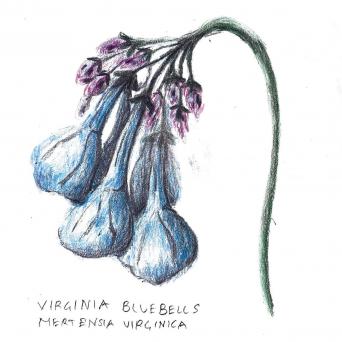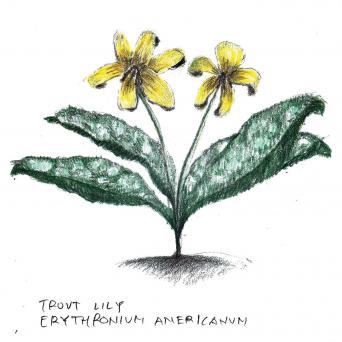
Liberate Your Lawn & Garden: Celebrate the Season with Spring Ephemerals
Spring-flowering ephemerals are a beautiful thing! Fleeting by nature, these delicate spring beauties appear seemingly from out of nowhere to suddenly dance across our barren woodland floors. Rising up out of decaying duff, the delicate blooms take full advantage of the early spring sun’s warmth before quietly disappearing back into the forest floor as tree leaves begin to shade the ground. Blink, and we humans will miss them.
However, our early native pollinators do not play a critical role in the production of pollen and nectar in the way that spring-flowering ephemerals do. This is why, for those of us in Northwest Philly, spring-flowering ephemerals are a welcome addition to our early shaded gardens.
During this time of COVID-19, I’ll use any excuse to get out into the woods, including a hunt for Trout Lily (Erythronium americanum). I say hunt, but it’s more of a hiking “I Spy” game that my nine-year-old can totally get into when she wants. And last week’s game did not disappoint!
I had a notion we would find Trout Lily down by the river, but this walk was seriously magical. We started off from Kitchens Lane heading west on a small trail, and before we were 100 feet in, I was completely caught off guard by a small cluster of Purple Toadshade (Trillium cuneatum). We would have totally missed it had it not been for the large pile of dog poo I was steering my daughter around. (Really, in the middle of the trail, people!)
I have three species of Trillium (T. cuneatum, T. grandiflorum and T. sessile) in my garden nestled between Bluebells (Mertensia virginica), but none of them are as large, healthy and vibrant as these were. After enthusiastically admiring them, my daughter bounded off, only to stop short and yell that she had found even more. Yes, this was going to be a great game today! Further down the trail, set back among the ever burgeoning green and yellow carpet of invasive Lesser Celandine (Ranunculus ficaria) was an even larger cluster of Toadshade towering over newly emerging umbrella foliage of Mayapple (Podophyllum peltatum). And get this: right next to it was a small single white flower of Sanguinaria canadensis, or Bloodroot. To say this was exciting is putting it mildly, as we had only walked 250 feet!
Two hours and three dozen photos later, my daughter had memorized the name of Mayapple by chanting Podophyllum peltatum over and over again to the rhythm of her steps, and in our hike we had “spied” a dozen spring ephemerals gracing the Wissahickon’s woodland slopes — some in small colonies, others in large swaths. Our finds included teeny Bluets (Houstonia caerulea), pale pink Spring Beauty (Claytonia virginica) and Rue Anemone (Anemonella thalictroides), white Dutchman’s Breeches (Dicentra cucullaria) and Twinleaf (Jeffersonia diphylla), yellow Celandine Poppy (stylophorum diphyllum), purple Northern violet (Viola), tasty Wild leeks or Ramps (Allium tricoccum), early Merrybells (Uvularia grandiflora), and, of course… yellow Trout Lily!
If you think your garden is stark this time of year, I encourage you to explore planting spring ephemerals to add color, delight, and critical habitat for our emerging community of pollinators.
Sarah Endriss is principal of Asarum LandDesign Group, a woman-owned firm specializing in ecological landscape design, and adjunct Professor in Jefferson University’s Landscape Architecture Program.



